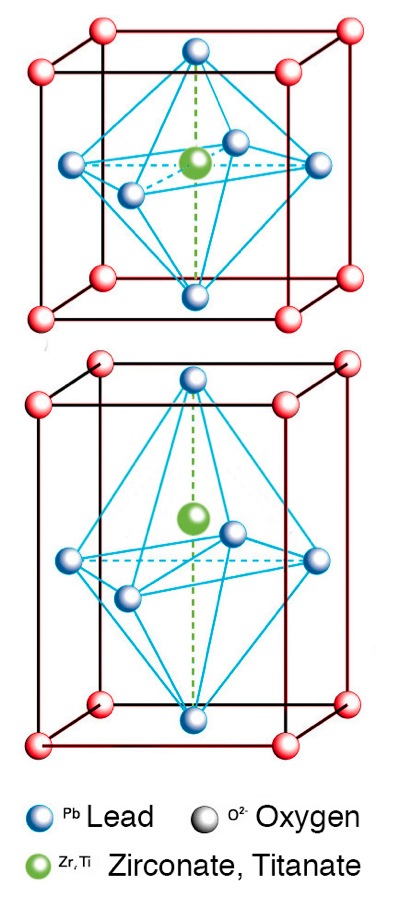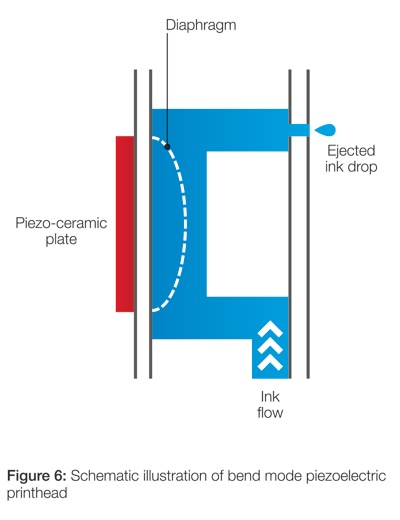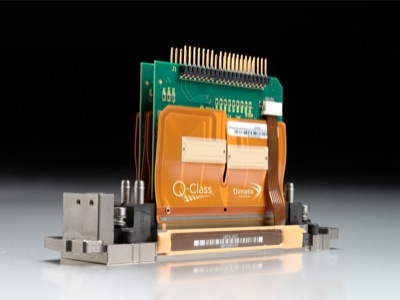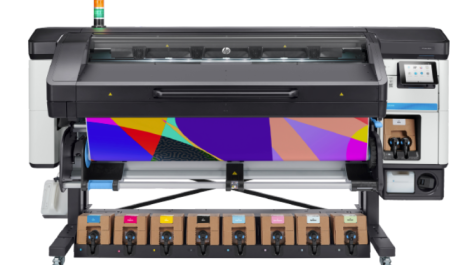Printheads are the pulsing hearts of inkjet printers. Simon Eccles provides a quick guide to how the main types work.
Inkjet technologies dominate large format digital printing for sign and display work and are increasingly appearing in smaller, faster production-class presses for commercial, packaging and labels work.
The heart of any inkjet press is the printhead, the part that forms and ‘jets’ precisely controlled droplets of ink at the printing substrate, which can be paper, plastic or a wide range of other materials. Here we look at how the main types work and why they sometimes do not.
Printer configurations
Although there are hundreds of printer makers worldwide, they all obtain their printheads from a relatively small number of specialist manufacturers, and then integrate them into the printers themselves with a combination of mounts, electronics, ink feeds, firmware and software.
A few printer makers own and operate their own printhead factories, including Canon, Epson/Seiko-Epson, HP and Fujifilm Dimatix (originally called Spectra), Konica Minolta and Xerox. The rest are all OEMs of specialist printhead manufacturers, including most of those listed above and others such as Kyocera, Memjet, Panasonic, Toshiba TEC, and Xaar.
In today’s production class inkjets, printheads are replaceable components that are often mounted in multiple arrays whose configuration largely determines the quality and number of colours available. Although wide format multi-pass and singlepass printers have very different configurations, the same printheads can often be used or adapted for either use. The main difference is how they are mounted onto plates or bars.
Wide format printers mount heads in moving carriages that build up the image from a series of overlapping print passes. Single-pass arrays generally mount heads in alternating or staggered patterns with some overlap: only a handful, such as the Memjet Waterfall or Fujifilm Dimatix Samba, are specifically designed to butt together to form continuous page-wide arrays.
Continuous inkjet
Continuous inkjet (CIJ) heads were often used in early inkjet proofers such as the DuPont Digital Cromalin and Scitex Iris. The printhead generates a continuous stream of charged droplets, which are deflected in flight by an electric field, either towards the print media, or into a catch gutter for recirculation.
Today, inkjets are largely used for coding printers for corrugated boxes and the like, although Kodak still uses continuous flow for its Versamark high speed web fed inkjet ‘presses’ for transactional printing. Kodak has also developed a very sophisticated and high quality CIJ variation called Stream, which it uses in its Prosper S-series printheads and in Prosper Press web fed printers for direct mail, books and periodicals.
Drop-on-demand
Kodak apart, all modern production inkjets and proofers use drop-on-demand (DoD) printheads.These can be precisely controlled to produce ink drops when required. There are two major types of DoD printhead, thermal and piezo. The DoD term was originally coined to distinguish such heads from the continuous inkjet (CIJ) heads (see below), which fire droplets continually rather than on-demand.
Any drop-on-demand printhead used for decent quality print will have multiple nozzles that can be controlled and fired individually – typically 256, 512 or 1024 nozzles per head, with a pitch of perhaps 180, 360 or 720 nozzles per inch that determines the native printing resolution of the head. Each nozzle will have a diameter roughly on the scale of a human hair.
Thermal DoD
Thermal heads were the first to reach a mass market and continue to dominate the home and office markets. They are rarely seen in production printers. However, HP uses thermal heads for both its Latex large format printers and its big T-series inkjet web presses. These are variants of those used in HP office and photo printers, so pro printers get the spin-off benefit of low cost and easy replacement.
They only work effectively with aqueous (water based) dye inks, meaning they are rarely suitable for weatherproof outdoor signage printing. A significant exception is HP’s Latex Ink signage printers, which use thermal heads and a water based ink that contains weatherproof polymers.
 A thermal inkjet head, with the thermal resistor creating a superheated vapour bubble that forces drops of ink from the nozzle
A thermal inkjet head, with the thermal resistor creating a superheated vapour bubble that forces drops of ink from the nozzle
Inside a thermal printhead are a series of ink chambers, opening onto a nozzle. A thin film resistor element inside each chamber is rapidly heated by electrical current. A bubble of superheated vapour forms and forces a drop of ink out of the nozzle (hence Canon’s trade name of Bubble Jet). Then the heat is switched off, the bubble condenses rapidly and the pressure reversal draws replacement ink into the chamber.
The narrow chambers and minute amounts of ink mean that heating and condensation in the range of 300 degrees C are very rapid, so the printheads can fire very quickly, thoughthey also heat up, which is one reason why they are not suitable for highly volatile solvent inks.
The heating and cooling cycles and the bubble collapses put stress on the head and degrade the electronics so they do not last as long as piezo heads. But they are made by the millions, so replacements are cheap and they are designed to be easy to remove and replace.
Piezo DoD
This is the most commonly used printhead type in wide format inkjets, and it is also often used in production presses for label, packaging and commercial work (though not the big HP T-series and Kodak Prosper web fed presses, which use thermal and continuous heads respectively).
The technology can be adapted to work with all types of fluids, most commonly aqueous inks, solvent inks, UV-cured inks, dye sublimation and other textile inks, as well as more exotic liquids for materials deposition, electronics and even medical use. There is a wide variety of configurations possible in piezo printheads, but the principle is always the same.
A piezo-electric material is a crystalline material that emits an electrical current when it is deformed (such as by squeezing). However, if instead you send a current through the crystal, it reacts the opposite way by changing shape – this ‘reverse piezo effect’ is used to create an ink pump in printheads.
In a piezo printhead, each ink chamber contains elements of piezo material, with an ink feed and a nozzle. When you pass a charge through the piezo crystal it changes shape, with the effect that a drop of ink is ejected from the nozzle. When you switch the charge off, the piezo contracts back to its rest position and replacement ink is drawn into the chamber. Switching is incredibly fast, so millions of droplets can be generated per minute in a multi-nozzle head.
Piezo printheads run cooler than thermal heads and they are designed to have much longer lifetimes, sometimes as long as the press itself. The piezo material can be activated billions of times before it stops working. On the other hand, they cost considerably more to make and buy than thermal heads,and highish replacement costs mean you need to put more effort into maintaining them, using good quality ink and avoiding damage from head strikes.
 Atom arrangements in a PZT piezo crystal. The bottom crystal lengthens as an electric charge is applied
Atom arrangements in a PZT piezo crystal. The bottom crystal lengthens as an electric charge is applied
Piezo variations
The shape-shiftingpiezo crystal is arranged in two main ways in printheads. For bend mode configurations, an element made of laminated piezo crystals is fixed firmly at both ends and attached behind a diaphragm on the wall of each ink chamber in the print head.
As a current is passed through the piezo element, it tries to lengthen, but the fixed ends force it to deform outward, making the diaphragm expand. This pressurises the ink in the chamber and forces a drop out of the nozzle. When the power is switched off, the piezo and diaphragm return to their rest position, and the pressure reversal draws fresh ink into the chamber. Shear mode is a bit different.
Here the piezo crystals are arranged to expand widthwise, shearing one edge sideways. This is done at high frequency, so that instead of physically pushing ink out of the nozzle, it creates an acoustic pressure wave that does the job. Less energy is needed than bend mode, so power consumption is less and the heads are stressed less so last longer.
Dimatix uses a dual shear mode element that is placed on the roof of the chamber, with the nozzle at the end opposite the ink feed. In Xaar 1001 printheads, two shear mode piezo elements are stacked on top of each other to form common side walls of each firing chamber, firing alternately. These shear along their common centre edge, so that viewed end on, the walls form a chevron when they flex. The nozzle is perpendicular to the lengthways flow of ink and about halfway along the firing chamber. The drops fire down at 90 degrees to the flow. Xaar calls this its Hybrid Side Shooter architecture (HSS), and claims it is unique.
Nozzles and flows
Where the nozzle is placed is also important, with names like end-shooter, side-shooter, roof-shooter. In an end-shooter arrangement, the nozzle goes at the opposite end of the ink channel to the ink feed, with a diaphragm piezo element (or thermal heater element) in the middle.
The nozzle end of the chamber points down towards the media. In a side-shooter, the nozzle goes in the middle of the chamber wall, and therefore fires sideways at 90 degrees to the main ink channel. However, the chamber is aligned in the head so the direction of nozzle firing is of course downwards at the media and not really sideways.
There is also the roof-shooter, where the nozzle is central in the chamber, but the piezo or heating element is above it, on the top wall, ie the roof of the chamber. Again, the head is aligned in the printer so the actual direction of nozzle firing is downwards.
Ink optimisation
A given printhead design will be able to handle a variety of different ink types, but it will be tuned by the manufacturer or integrator for the particular type that the printer is intended for. UV, solvent, eco solvent and so on all have different jetting characteristics, and these vary from brand to brand.
The head is fine tuned for a particular ink by ‘waveform optimisation’ which means finding the exactly correct electrical signal (waveform) in the head to generate correctly formed drops.
The chief variable from this point of view is the viscosity of the ink fluid. Viscosity is also dependent on temperature, so high end heads often have temperature control of the ink supply, sometimes including a water circulation temperature control in the printheads.
 Bend mode piezo arrangement
Bend mode piezo arrangement
Preventing blockages
Ink is fed into printheads from feed containers that are usually user-replaceable cartridges or refillable bottles and tanks. Considerable effort is made to exclude or remove any dirt particles, as these can block the nozzles.
Air bubbles that build up in the final ink chamber also can block the nozzle by forming an airlock, so manufacturers do their best to prevent them getting there or remove them if they do arrive. Dimatix passes the ink through a ‘lung’ chamber before it reaches the printhead. This has a permeable membrane that air can pass through, but ink cannot.
Pumping the ink into the lung causes dissolved air to come out of the solution as bubbles that are drawn out by a partial vacuum on the other side of the membrane. The degassed ink will mop up and disperse any air bubbles it encounters elsewhere in the system, especially in the heads. Some manufacturers recirculate ink through the feed lines and heads, which helps to stop air bubbles and dirt building up (it is also needed for heavy pigment inks such as white, metallic and ceramic).
Xaar claims that its TF (Through Flow) Technology in its 1001 head is the only system that can actually recirculate ink above and past the nozzle in the ink chamber itself. This is tied in with its Hybrid Side Shooter head design (see above), where ink is continually pumped in one end of the ink chamber and out of the other end where it is passed back to the tank. Air and any unwanted particles never get the chance to build up.
Binary and greyscale
Piezo printheads were originally always binary, meaning they would only generate ink drops that were all the same size. You can get a respectable range of tones from a binary head by using halftone techniques, but the results can be a bit grainy in the highlights. Recent years have seen the development of greyscale (also called multi-level) heads. These can vary the density of individually printed dots.
Combined with halftoning techniques, greyscale can considerably extend the tonal range of an inkjet while allowing relatively modest nozzle pitches or fewer passes to be used. Typically a resolution of 360 dpi with a greyscale head is said to give the same quality impression as 1000 dpi binary.
Precise methods for varying the droplet density vary between head manufacturers, largely due to patent issues. However, they all work by rapidly generating variable numbers of ‘sub-droplets’ in each nozzle, which merge to form larger drops before they reach the substrate.
Epson’s micro-piezo design, first developed in the 1990s, seems to have been the first commercial greyscale head. These generate between one and five sub-drops per nozzle. Xaar’s 1001 greyscale heads can generate up to seven droplets, while Fujifilm Dimatix’s Q-Class heads can switch between greyscale and binary mode depending on your requirements.
Futures
It is tempting to assume that head resolution is the main variable in an inkjet printer. This is not the case though, as issues such as greyscale, ink optimisation, driver electronics and screening all play a vital role in all aspects of performance.
Printhead developers are always cagey about their future plans, but it seems certain that as press manufacturers gain experience with integration and control, even today’s head designs will lead to ever greater performance.





